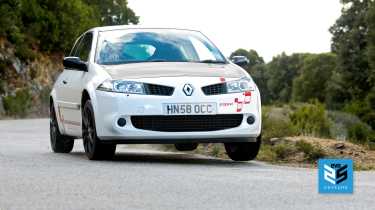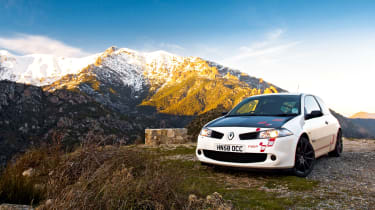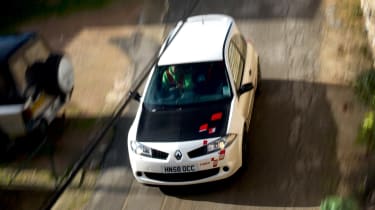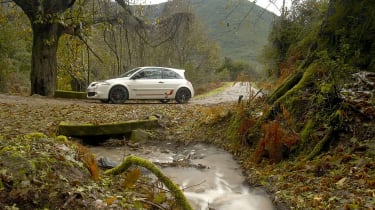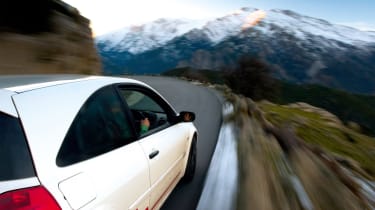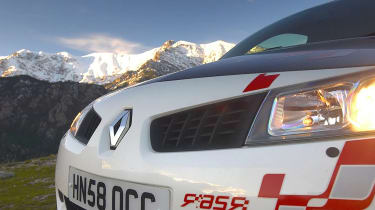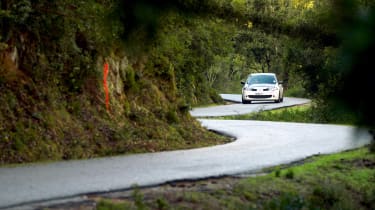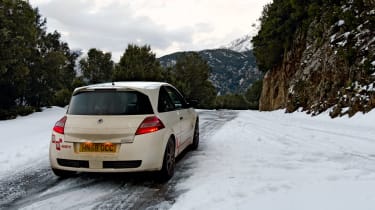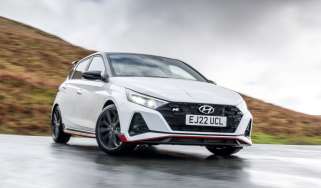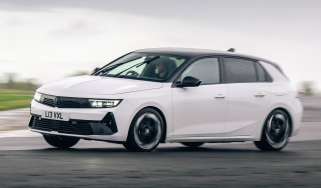Renault Sport Megane R26.R (2009): the most significant hot hatch of the last 25 years
For much of the last 25 years, Renault ruled the hot hatch world. The ultimate expression of its brilliance, the R26.R
Funny, isn’t it, how hot hatches have got very serious indeed in recent years – to the point where anything with less than 300bhp and an assortment of wings, vents and aerodynamic flicks seems distinctly undernourished.
Given all of that, when looking back at 2008’s Renault Sport Mégane R26.R, you could be forgiven for wondering why those of us who were there still refer to it with such reverence. After all, it musters just 227bhp, which doesn’t even qualify as warm these days for a C-segment hatchback, and then there’s its Nürburgring lap time, the first occasion such a claim had really been applied in a marketing sense to a hot hatchback. Eight minutes and seventeen seconds, you’ll recall; impressive at the time, but barely breaking into the class top ten these days, given that the new Honda Civic Type R can lap in potentially under 7min 40 (adjusted for the older configuration used in 2008) complete with a comfortable and well-specified interior and ‘normal’ tyres.
> Renault Sport Clio 182 Trophy (2005): review, history, prices and specs
In an era of excess, the R’s French-hire-car-meets-recce-car simple functionality, whatever the now-rather-naive unpainted carbon bonnet and graphics might want to suggest, feels almost effete. But it’s precisely that same simplicity that’s the clue to its genius, because the R26.R is an extraordinarily thorough engineering exercise by a team of engineers, designers and test drivers at the very top of their game. This is the car that will always define the Renault Sport years of the early 21st century, when the team from Les Ulis ruled the world.
It takes dedication, inventiveness and extreme powers of persuasion at senior manager level to remove 125kg from the weight of a fully homologated hatchback, but that’s exactly what Renault Sport achieved with the R, and it’s the foundation of its mastery.
To do so, the R goes radical. Firstly, it crosses the beams of the hatchback world by losing the rear seats, willingly opening itself up to ridicule from some and also to inevitable and more direct comparison with far more exotic, purely two-seat machinery.
From there, it removes not only the front seats, replacing them with pure buckets from Sabelt, but also ditches the inertia-reel belts for four-point harnesses, saving 25kg. The bonnet is carbonfibre, the wheels lighter, but then there’s the car’s pièce de résistance: the polycarbonate rear and rear-side windows. Nothing says ‘serious’ like the replacement of glass with plastic…
The rest of the weight saving was achieved by parsimony with the specification list. The door mirrors are adjusted with a little stick, not electrically; there is no passenger’s airbag, or curtain bags; no front fog lights in the Mégane’s blocky front bumper, and perhaps the biggest statement of all, not even a radio. What the eye can’t see is the removal of various pieces of sound-deadening material as well.
> BMW M3 GTS vs Mini GP vs Renault Sport Mégane R26.R
Mechanically, there were new grooved brake discs and a shorter throw for the gearlever, but the snorty, peculiarly nasal-sounding turbocharged in-line four was left unchanged, save from doing without the extra grams of its usual, stylised plastic engine cover under the bonnet.
For the full R experience there were two important options. A further £700 bought the substantial half roll-cage that occupies the space where the rear seats once were, and was combined with a set of Toyo 888 semi-slick, but road-legal, rubber that replaced the standard-fit Michelin Pilot Sports. A further £2250 secured a titanium exhaust, saving further weight, giving the car a hard, breathy exhaust note, and turning a seared shade of blue with the application of some heat. Lovely.
You sit a little high in the R, but thanks to plenty of reach adjustment of the steering wheel (for a moment I couldn’t recall if Renault Sport had ditched that too like they did with the contemporary Clio 200 Cup, but thankfully not) the driving position is good. A glance around reveals a simple, rather plasticky interior, but one that also provokes a pang of nostalgia for Renault’s inventive and idiosyncratic design of the period, particularly compared with the blandness of more recent offerings.
If you’re turning out of a junction or driveway to get going you’ll feel the gentle interventions of the torque-sensing limited-slip differential, but once up to cruising speed the R is oddly serene. Sure, the tyres constantly sing as though the wheel bearings are shot, and a sporadic gunfire of gravel pings on the less-insulated underside, but the R driver learns to compartmentalise this through the brain’s own noise-cancelling software, and it’s the sheer delicacy and fluidity of the car that astounds.
Far from being an overly aggressive, stiff-riding track refugee, the R is brilliantly at home on a B-road. Thanks to the significant weight saving, the engineers were able to actually reduce the spring rates, and while the damping deals with anything that’s thrown at it decisively and in short order, the edges of the ride are buttery smooth. The steering, despite being electrically assisted, is beautifully subtle, precise and amazingly communicative, and gentle pressure on the wheel can adjust your chosen line down to the last millimetre. It’s soon clear that it’s a car that can be driven with the fingertips, not muscled, the same applying to the gearlever, which can negotiate the gate with the lightest of touches.
You’ll want to go faster, of course. It goads you, constantly. And then you’ll go faster still, and faster, and soon find that it covers ground as rapidly as anything else you can think of, in part because it feels like there’s no combination of corner and road surface that could ever catch it out. The poise and agility still astound, all these years later, and once you’re into a corner and on the power the diff’s intervention means the car’s nose actually tightens, even when you feel like you must surely be near the limit of grip. Ultimately, while those limits seem beyond reach on the public road, the R doesn’t suffer from the modern performance car disease of operating too far within itself, because the driving experience at any speed is so rich and rewarding.
The engine plays a supporting role. Its hearty torque delivery combines with that lighter kerb weight to give the R a deliciously effortless way of accruing speed, but flat-out there’s no denying it lacks the fireworks we’ve become accustomed to. It matters not one jot. The motor is an enabler to everything else, and that’s more than enough.
Yet for all the hyperbole, the simple, now unfathomable truth is that the R26.R was a sales disaster. Despite the plaudits from the motoring press, including fourth overall at evo Car of the Year 2008, Renault UK was left with a stock of unsold cars, eventually disposing of a number to the Swiss market. Maybe the market thought it was expensive at £23,815 (or £26,765 fully specced); maybe the concept of a two-seat hatch was yet to be fully appreciated. Whatever. That just makes it all the more painful – for those of us who don’t own one, at least – that values for low-mileage examples are now around the £40,000-£50,000 mark. That might seem like an incredible sum for a hot hatch, but just one drive in the R26.R confirms that this was a sublime creation – and the most significant hot hatch of the last 25 years.
What we said
We look back at our time with the R26.R on eCoty 2008, tackling some of the most spectacular tarmac stages on the rally calendar in Corsica...
It’s not much more than a ledge. One of the Renault’s Toyos skims the very edge of the tarmac as we squeeze past a recent rockfall, and a couple of small stones bounce once then vanish into the abyss, probably landing in the river below about a week later. Sixty-four years ago, the first Tour de Corse would have come along here, and the idea of driving this road at high speed in a Renault Dauphine (a car once described by Time magazine as ‘the worst piece of French engineering since the Maginot Line’ and undoubtedly equipped with nothing we’d recognise today as brakes) is enough to give you an incurable case of vertigo…
The Mégane R26.R, thankfully, has fantastic brakes, and as I proclaimed it ‘a tarmac rally car that you can buy from a showroom’ when we drove it at eCoty 2008 (evo 125), there seemed no better place to escape to in it than Corsica, the home of the ultimate tarmac rally. It is a doubly appropriate destination for the R26.R because that Dauphine clinging to the vertiginous mountainside won that first race in 1956, and Renaults would win ten subsequent Tours before Lancia began to dominate.
A little further down the precipitous road, we find a small outcrop to park on. The scenery onto which I open my door is as breathtaking as the drop and the surprisingly chilly air. We’ve only been here a couple of hours and already I know it’s been well worth the slightly arduous trip down. It’s over 700 miles from Calais to Toulon in southern France, and there seemed to be more infuriatingly sneaky gendarmes than ever on the péages yesterday. The Renault’s bucket seats also tenderise buttocks past the point of numbness after a couple of hours and, worse still, there’s no radio in the R26.R, so photographer Andy Morgan and I had to actually talk to each other.
Once at Toulon yesterday evening we boarded the ferry for the overnight bob across the Ligurian Sea to Ajaccio, birthplace of Napoleon and Corsica’s capital. Arriving early this morning as the stars were disappearing and the sky was turning grey-blue, the moody silhouettes of mysterious peaks were slowly revealed, rising fortress-like from the mist along the coastline. It looked like we were coming to the setting for Jurassic Park.
By the time we’d docked, morning rush hour was in full flow. Corsica might technically be French, but there is a very strong Italian influence and all the road signs are gradually being changed so that place names are in both French and Corsican (which is like an Italian dialect) – a bit like in Wales. Any signs in remoter parts of the island still left with just the French incantations are riddled with bullet holes and graffiti – less like Wales. This dual national identity had me bracing myself for a terrifying driving experience where the cars are piloted with a combination of the bravado of Italians and the spatial awareness of the French. Eventually, with the help of the lady in the TomTom, we managed to extract ourselves from Ajaccio (Aiacciu in Corsican) and headed northwards in pouring rain.
I should point out that we didn’t really know where we should be going, because information on the Tour de Corse is surprisingly scarce. I’d spent hours on the internet, and although I’d managed to get the stage maps for more recent years, finding anything about the rally’s past proved immensely difficult. Even my father’s usually reliable library of Motor Sport magazines from the ’50s, ’60s and ’70s was strangely silent because the Tour de Corse wasn’t part of the FIA Rally Championship until it was included in the new World Manufacturers’ Championship in 1973. The best help I got was from evo’s own Richard Meaden and his excellent Classic Motorsport Routes book (available from all good online auction websites, perfect for birthdays), but even the map in that was rather vague. Nonetheless, with a large-scale road atlas and our fingers crossed, we headed off.
We needn’t have worried. It seems that wherever you turn off a main road in Corsica (and as we’ll discover later, even the main roads can be quite amazing) you come across a potential rally stage. The first road we headed for descended then climbed through dense, lush greenery dripping with rain. If it hadn’t been so cold then it would have been tropical. The road was no more than a car and a half wide and seemed to twist and turn endlessly, briefly emerging over a spectacular bridge before plunging back into the trees that hid it from view when you looked back across the valley.
Road maintenance is on the slack side in Corsica and in many places nature seemed to be fighting and winning the battle to reclaim for herself the ground that man had etched out of the hillsides. Rivers and streams ran under the roads, and rocks had loosened themselves from the banks and cliffs to provide unnerving impromptu chicanes around blind corners. The Mégane was already proving that it was the perfect car to bring, the steering so precise and the control of the chassis so absolute that I could use every last millimetre of the available surface when skirting round obstacles or flirting with apexes. Even more importantly, over the more lumpen sections wheel movements were damped to perfection, allowing the Renault to carry speed that would make a supercar driver cry. Where other cars would have wobbled, pounded bump-stops or scrunched splitters, the R26.R was flowing down the road.
As we approached the end of the first epic stage, we spotted Corsica’s famous red rocks – Les Calanches – on the other side of a wide valley. Halfway up them was a tiny speck of a car tracing a meandering line across the surface. Half an hour later, we are that speck. I’m trying to imagine Gilberte Thirion in her Dauphine or Bernard Darniche in his Alpine A110 as they came along here, quite possibly at night. There are even more random razor-edged rocks on the road here and the consequences of the certain puncture if you hit one don’t bear thinking about. The original rallies took almost a week to complete and really were a tour of the whole island. The Tour de Corse was known as the ‘Rally of 10,000 Corners’, and from what I’ve driven of it already, I reckon it must have felt like the rally of 100,000 corners.
The longest stage of the modern rally seems almost puny at ‘just’ 47km, but even that must be an absolute nightmare. With literally no straights and every corner contorting into the next, there can’t be a moment’s rest in the rapid-fire stream of instructions coming from the co-driver. It’s no wonder drivers sometimes get tunnel vision as the road blurs continuously in front of them…
After a couple of hours’ photography we’re standing on the outcrop once more, taking in the view. The snow-capped mountains seem to be calling out as our next destination. Looking at the map, I think they must be over towards Tavera – and a cluster of stage miles with a particularly poignant resonance.
Corsica is a big island, some 114 miles long by 52 miles wide, and it takes some time to reach our destination because we have to descend back to the sparkling sea-trimmed coastline before we can head inland again towards the mountains. After an hour or so we dive off the main road once more and head up to Tavera on the road from Carbucci. With the sun sinking fast behind us and patches of snow appearing at the sides of the road we press on.
We’re going in search of the memorial to Henri Toivonen and Sergio Cresto. The pair’s tragic death in 1986 signalled the end of the era of Group B cars. The immensely talented Toivonen was one of the heroic few capable of taming the likes of his fearsome Lancia S4, but even he knew that it was a tightrope. He was some way in the lead of the rally after a string of fastest stage times when he said to reporters: ‘This rally is insane. Even though everything is going well at the moment, if there’s trouble I’m as good as dead.’ The words must have been chilling enough in the sunshine of an afternoon, but with hindsight they are horribly haunting. Shortly after he said them, 4.5 miles into stage 18, the Lancia inexplicably left the road and the ensuing fire left nothing but a charred chassis.
Threading through the streets of Tavera, the road winding around buildings, it’s hard to imagine controlling a 500bhp monster in such confined spaces. As we head out on the road to Bastelica and leave the small town behind, the snow is lying in drifts at the side of the road, and the further we go, the more it encroaches until soon there’s just two dark lines stretching out through the white covering ahead of us.
The hairpins are starting to prove tricky now and our pace has been reduced to a crawl as the road winds more steeply upwards and the near-slick tyres start to spin on patches of ice. If we stop I’m not sure we’ll get going again and I don’t think this is quite what Renault Sport envisaged for the limited-slip diff.
Eventually we reach a junction; although the road to the right continues to climb, there is simply too much snow. I park up and get out to have a look at the signs and to see what the road looks like if we go left, as I don’t much fancy going back down the way we’ve just come. Unfortunately it looks like Sweden or the Monte, so we could be skiing most of the way down, but short of waiting for spring there doesn’t seem to be a lot of choice. Left it is.
It’s quiet in the car for the next half an hour and there’s a definite air of tense concentration. Although it’s getting dark and the drops are being hidden from view, neither of us wants the gravity-fed slithering to get out of control. Gradually pinpricks of light from a village emerge below us, the snow recedes and Andy and I start breathing again. It’s a great shame that we couldn’t pay our respects to Henri and Sergio, but nobody can say we didn’t try.
The following morning the grubby white Renault looks every inch the rally-recce car in the starkly lit underground car park. Fresh from a night’s sleep, we’ve decided that we’re going to explore the stages south of Ajaccio today, before heading north-east to Bastia where we’ll catch our overnight ferry back to Toulon.
It’s a beautifully clear day, but as we drive past the white aerosol-painted line that still marks the stage start, the trees stretch their canopy over the road once more and we plunge into another narrow rollercoaster. From watching on television, one of the things I associate most with the Tour de Corse is the plunging cambers on the inside of turns, the cars tilting left and right as they pick a line straight through them. Those very cambers are in strong evidence here, complete with numerous lines gouged into the tarmac where armour-plated sump-guards have slumped onto the road as wheels have dropped off the edge taking the tightest line possible.
There’s a good downhill hairpin where I get to try out the Mégane’s handbrake, but the best bit of driving road is just a little further up the hill. It’s clear of the trees up here and the surface is almost orange in colour. It’s just a bit wider too and well sighted, so you can attack as hard as you like. The surface is still just slightly greasy in the shadowy sections, something which should be horrible, especially on such lightly treaded tyres, but, probably because I’m weird, I love it. With care, the 888s can be teased to the edge of their grip and it’s a glorious feeling as the car moves around underneath you.
I know some people hate harnesses in road cars, but I don’t, and the Renault lives up to them. You need to pull the wide, red Sabelt straps down tight over your shoulders so that they’re pushing you into the seat’s foam. Once compressed thus you feel so much more part of the car’s reactions that you don’t want to drive without them, although admittedly when you stop driving quickly the discomfort means your first instinct is to slacken them off again.
In the sunnier sections the changes of direction you can achieve, the grip you can find and the way that the R26.R’s diff-equipped front end can rip you through a corner, accelerating all the way around the curve from the moment you turn in, gives me goosebumps. What weight there is in the car seems to be underneath you at axle height, so the centre of gravity feels no higher than a snake’s spleen and the Mégane feels completely planted, allowing you to get into an almost metronomic rhythm of left, right, left, right through the bends. There’s even a good bump on the exit of one of the corners that you can bounce the Mégane through and out of. It’s hours of fun.
At lunchtime we descend into a village and, completely by chance, find a reminder of Renault’s Group B days in the shape of a perfectly scruffy 5 Turbo 2. It’s even in the same pearlescent white as the Mégane, and if the owner had been around I think Andy would have made him an offer there and then. I almost suggest coming back tomorrow so that we can spend another day in Corsica.
But the ferry and the real world are waiting, so we head back onto the main road, the N193, for the slog up to Bastia. Yet even here there is one last surprise in store. The ‘main road’, trimmed with fresh white snow, sweeps up into the mountains through turn after turn. It would be perfect for a supercar. We’ll have to come back.
After two days, it’s obvious why the Tour de Corse is the ultimate tarmac challenge. The bravery of the drivers, from Thirion in her Dauphine, through Toivonen in his S4, to Loeb in the noughties, is staggering. If you can find an excuse, go there and marvel – it’ll be worth it. Nowhere I’ve been to in the world has combined such a wondrous natural landscape with roads so perfectly draped over it. – Henry Catchpole, evo issue 276
Renault Sport Megane R26.R specs
| Engine | In-line 4-cyl, turbo |
| Displacement | 1998cc |
| Max power | 227bhp @ 5500rpm |
| Max torque | 229lb ft @ 3000rpm |
| Transmission | Six-speed manual gearbox, front-wheel drive, limited-slip diff, ESP |
| Brakes | Ventilated discs, 312mm front, 300mm rear, ABS, EBD |
| Weight (kerb) | 1220kg |
| Power/weight | 189bhp/ton |
| 0-62mph | 6.0sec (claimed) |
| Top speed | 147mph (est) |
| Price new | £23,815 (2008) |

